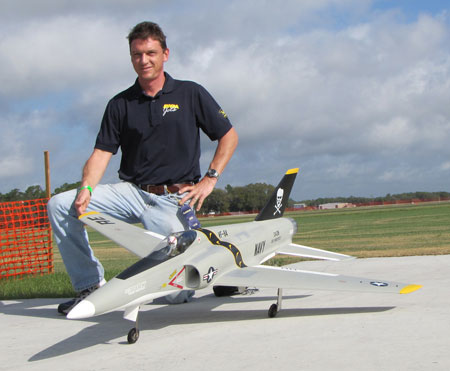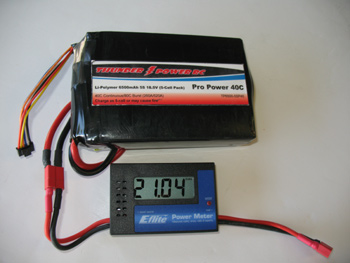 

Success with LiPo Batteries,
LiPo Battery Break In, Warning
LiPo Storage
In-Practice
by Bob Violett
We have all heard/read about the various theories concerning the proper
procedures for Lithium Polymer battery use and storage. We now have
"In-Practice" conformation that our EVF power batteries
should be stored at their optimum storage voltage of
3.85+- .05 per cell.
|
| Tommy Wood of
Lakeland, Florida flies his EVF 12 powered Electra alot,
literally about three hundred flights per year. Tommy's
practice of faithfully storing the batteries properly
between flying sessions has provided evidence that this
procedure really works. |
 |
| Tommy
has (2) two year old sets of ThunderPower (3) 45C 4S 2P
6500mAh packs with 120+ flights each that are still
going strong. They are flat, firm and produce
close to brand new performance. The chemistry in
the 65C batteries from ThunderPower is measurably
improved over the 45C series, so we can expect even
better service life. |
| |
|
|
Appropriate Chargers
The FMA PowerLab 6 or 8
and the CellPro 10XP have a "Storage Charge" feature.
We now know to use it. It is BVM's practice to not
leave the batteries fully charged for more than a few
days and to store them at room temperature.
Internal Resistance
Another important
feature of these modern chargers is their ability to
detect and record the internal resistance of each cell
in a pack. The "I.R." is the best measure of a
LiPo battery's capability to deliver Watts. We
record these numbers when the packs are first put into
use, then keep track of the number as we accumulate
flights. As the packs age, these numbers will
creep upward but should remain fairly even cell to cell
within a set of packs.
If you are using the
PowerLab 8 for fast parallel field charging, we have
found it helpful to occasionally slow charge the
batteries on the CellPro 10s or XP to verify the per
cell I.R.
Tommy Wood is using:
Charger - (2) CellPro 10s
Storage Temperature - Room Temperature 75°-80°
Number of sets of ThunderPower - 3 sets
Current I.R. of cells - 1.2-1.5
Note: The CellPro 10s will
bring batteries up to storage charge after a flight.
It will not discharge the batteries. |
|
Always check the voltage of the Saddle
Cells and Booster packs just before flight. |
|
Our practice is to check them prior to
installing the packs in the model at the field. It is essential that
the fully charged voltage reads within .10V for the Saddle Cells and if a
Booster pack is used, the corresponding voltage for a 2 cell pack.
The total variance should be .10 volts or
less.
i.e.
5s pack Volts = 21.00 +/-
.05
4s pack Volts = 16.8 +/-
.05
2s pack Volts = 8.4
+/- .05
|
 |
|
Note:
Following this procedure is very important to protect your
investment in the batteries and your model. An out of balance mix of
batteries will damage them and cause a sudden loss of thrust early in the
flight. BVM uses the Power Meter from E-Flite. |
Lipo Battery Break-In
It's a concept that may be difficult to accept
because we can not observe the chemical exchange taking place inside
each cell. But, it has been established in practice, that
properly exercising LiPo cells during their initial use will
contribute to the power output and increased cycle life.
Some Guidelines
For BVM "Matched Cell"
Break-in
Install the Saddle CellsTM
in your model using adhesive backed Velcro to adhere them to the
plywood battery support shelf in the fuselage.
For break-in purposes, they can rest on foam pads on the wings.
Make sure that your transmitter
(Spektrum 7) ATV adjustment's are set to approximately 85% for high
throttle and 75% for low throttle.
The goal is to run the freshly
charged cells at 40-50 amps and consume about 70% of the available
capacity, keeping the battery core temps around 100°F
maximum.
To accomplish this without a
good quality amp meter, position the throttle stick about 2/3rds
position maximum and cycle it to low power a few times during a 2
minute run time. Adjust this time on the following runs to
accomplish the 70% consumption target.
You can immediately recharge
the batteries @ 1C if the temps are below 125°F.
Always use a cell balancer during charge operations.
Cycle the packs 5-6 times on
the ground at the shop. Then, fly the model conservatively for
the first few flights with the goal of utilizing about 70% of the
mAh capacity.
We realize that you may want to
show the guys at the flying field just how fast, how high, and how
long your EVF model will fly. If you follow this break-in
procedure, there will be plenty of time to do that later.
On subsequent flights, the goal
should be to utilize 80% or less of the pack capacity with post
flight pack temps below 120°F. Give yourself time to develop a
flight routine (profile) that maximizes the performance and flight
time without over taxing the batteries. Following this
break-in course will go a long way towards maximizing the cycle life
of your BVM power packs.
Aerodynamically clean models
like the BVM Electra, Sabre, and F-80 with EVF power allow some
power-off cruising time following high speed passes and zoom climbs
that add greatly to total flight time.
Note: Exceeding the 80%
capacity and 120°F guidelines won't necessarily ruin the batteries
but experience has shown that the cycle life may be reduced.
WARNING
Immediately after each flight, disconnect the fan power batteries from the ESC. If this procedure is not followed, the ESC will continue to draw a small amount of current from the batteries eventually depleting them below minimum voltage and possibly ruin the entire set of packs.
Connecting the Batteries to the ESC
It is a simple operation, but done incorrectly, can be harmful to the batteries.
The R/C link must be active (on) and the throttle and trim lever in the full aft (off) position. For the first operation of a new setup, be certain that the throttle channel is not reversed. The E.S.C. is set correctly at BVM and test run so it is not reversed
when operated by a JR/DSM/Spektrum radio..
Connect the Saddle Cells™ to the
Power Plug. A slight spark is going to occur during the connecting process (to E.S.C.) so be prepared for it.
Observe the female end of the Dean's connector. It is best to aim the brass male pins at the plastic side of the positive and negative receptacles.
The connection should be a smooth and deliberate action, starting with the positive (horizontal pin of the "T") first and rotating the connector together to engage the negative vertical pin.
Do not hesitate during the connection process.
The proper technique minimizes the spark and reduces erosion of the connectors.
Experienced EVF pilots know how to fuss over their
batteries by keeping records of flight times, temperatures, recharge capacity,
internal resistance
and total number of cycles etc.
Even with this close scrutiny a cell can occasionally
deteriorate. Your testing equipment may not pick it up. But should you
notice that during a flight, the power just doesn't seem right, i.e. what you
have gotten use to, land as soon as possible.
The deteriorating pack will begin to put extra demand on
the other Saddle CellTM.
Contact Us
All graphics and photos
Copyright 2016 BVM, Inc.
Use of graphics or photos without written permission from
BVM is
strictly prohibited.
|

